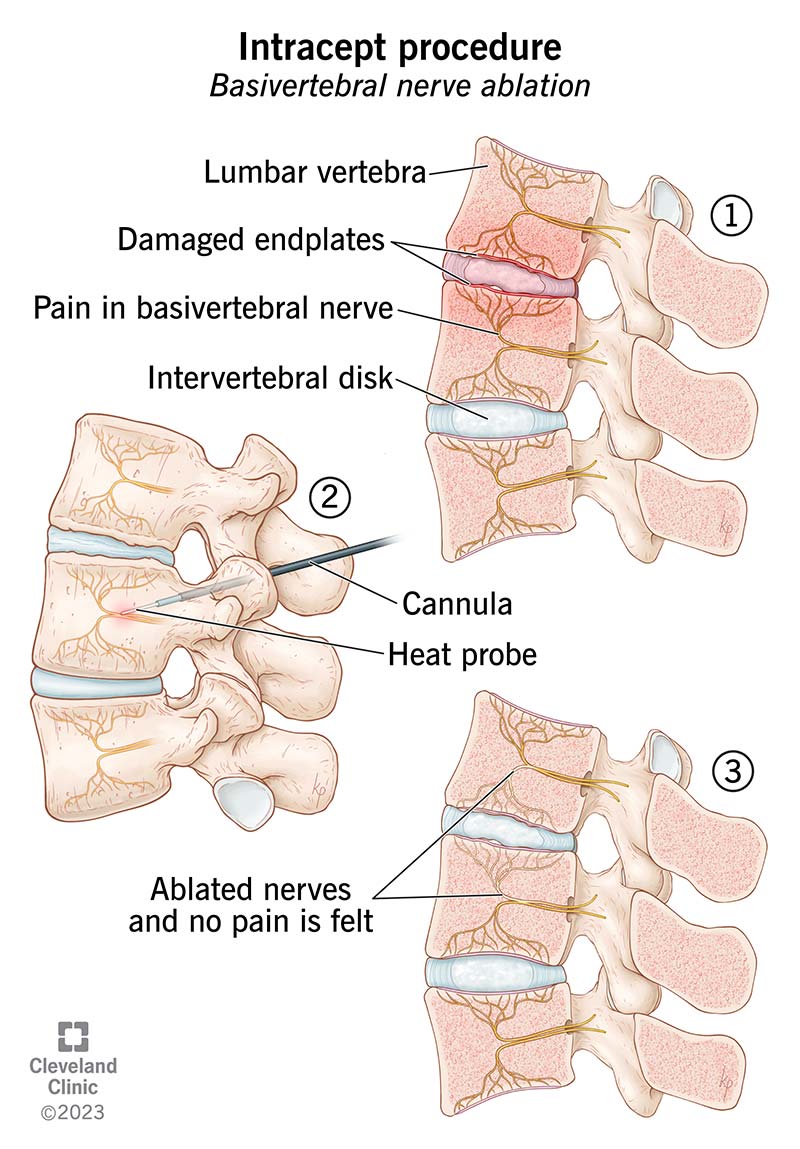The Intracept procedure — also called basivertebral nerve ablation — is a minimally invasive treatment for people with certain types of chronic low back pain. Providers often recommend it when other treatments like medication, injections and physical therapy don’t work.
Advertisement
Cleveland Clinic is a non-profit academic medical center. Advertising on our site helps support our mission. We do not endorse non-Cleveland Clinic products or services. Policy

The Intracept® procedure — also called basivertebral nerve ablation — is a minimally invasive treatment for people with vertebrogenic pain (a specific type of chronic low back pain).
Advertisement
Cleveland Clinic is a non-profit academic medical center. Advertising on our site helps support our mission. We do not endorse non-Cleveland Clinic products or services. Policy
Vertebrogenic pain literally means pain that begins in (“genic”) your vertebra (“vertebro”). It occurs when there’s damage to the endplates of your vertebrae (the bones in your spine). Your endplates are protective barriers located between your vertebrae (made of hard bone) and your spinal disks (made of cushiony, gel-filled cartilage). They also carry blood and nutrients to your disks. Damaged end plates can trigger pain at the basivertebral nerve inside your vertebrae.
Your basivertebral nerves run through the bone of each vertebra and branch off to supply each endplate. That’s why vertebrogenic pain is so specific.
The Intracept procedure uses radiofrequency energy to heat a narrow point on your basivertebral nerve. That disrupts pain signals that travel from your spine to your brain, offering relief from vertebrogenic pain.
Healthcare providers often recommend the Intracept procedure when nonsurgical options like medications, injections or physical therapy aren’t effective enough. It’s a less-invasive alternative to open spinal surgery.
Providers typically use general anesthesia for the Intracept procedure, so you’ll need to arrange for a loved one to drive you to and from your appointment. You should also tell your healthcare provider about any medications or supplements you’re taking. They’ll let you know if you need to stop any medications before your visit.
Advertisement
A healthcare provider will ask you to lie face down on an exam table. They’ll give you general anesthesia to make sure you’re comfortable before beginning the procedure. Then, your healthcare provider will:
The Intracept procedure usually takes between 60 and 90 minutes to complete. It’s an outpatient procedure. You should be able to go home once your sedation wears off.
Your healthcare provider will let you know about any restrictions following your Intracept procedure. In general, it’s a good idea to rest as much as possible and avoid exercise for about 48 hours.
Typical Intracept procedure side effects include slight soreness around your incision for a few days. Some people may develop bruising and minor swelling, as well. You can usually manage these side effects with over-the-counter (OTC) pain relievers like acetaminophen (Tylenol®) or ibuprofen (Advil®). Your healthcare provider will also give you a detailed list of post-treatment instructions.
The Intracept procedure offers several advantages for qualifying candidates:
Research suggests that the Intracept procedure is an effective and reliable treatment for people with vertebrogenic pain. In one 2023 study:
If you’ve had chronic back pain for at least six months with no improvement from conventional treatments, ask your healthcare provider about the Intracept procedure. They can determine if you’re a candidate.
Advertisement
While complications aren’t common, they can happen after any surgical procedure. Possible Intracept procedure complications include:
To learn more about Intracept procedure pros and cons, talk to your healthcare provider. They can tell you if this treatment is right for you.
Most people make a full recovery in about one to two weeks. You may be able to return to work or school as early as two or three days after the procedure. If you have a physically demanding job, you may need to take a few more days off work.
Recovery times can vary depending on your unique situation. Your healthcare provider can tell you what to expect in your case.
If you’ve recently had the Intracept procedure, be sure to call your healthcare provider if you develop signs of infection, including:
Yes, the Intracept procedure is a term that describes radiofrequency ablation of your basivertebral nerve. The trademarked term (Intracept) refers to the devices used during this procedure.
Advertisement
You’re probably not a candidate for the Intracept procedure if you’re pregnant or have:
Chronic back pain can interfere with daily routines and diminish your quality of life. But when nonsurgical treatments don’t work, the Intracept procedure can help. Treating vertebrogenic pain used to involve open surgery and much longer recovery times. Medical and technological advances now make it possible to treat this specific type of back pain with a single incision. If you’ve had chronic low back pain for over six months and conservative treatments haven’t helped, ask your healthcare provider about this innovative solution.
Advertisement
Low back pain can be a constant interruption in your daily life. Cleveland Clinic’s experts can help craft a treatment plan to help you find relief.

Last reviewed on 11/06/2023.
Learn more about the Health Library and our editorial process.